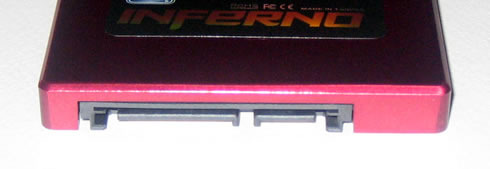1. Features
Patriot Memory recently introduced the Inferno series of solid state discs (SSD). The Patriot Inferno SSD offers all these great features found in SSD such fast transfer speeds, improved system responsiveness, quicker boot times, and shorter application loading times over traditional hard disk drive storage solutions.
Patriot's Inferno series, available in 100GB and 200GB capacities, is designed around the highly acclaimed SF-1200 processor series. Paired with MLC NAND Flash the Inferno drives promise to deliver sequential read and write speeds of 285MB/s and 275MB/s respectively. SandForce DuraClass technology also provides enhanced endurance and reliability by an average of 20x over traditional SSD controllers through innovative write technology and Wear Leveling.
We have already tested some products based on the SF-1222 controller, and most of them have demonstrated high operational performance and speed. Today we will test the 100GB Patriot Inferno SSD, model PI100GS25SSDR, against some other storage solutions on the market.

- Features
- Maximum sequential read speed 285MB/s
- Maximum sequential write speed 275MB/s
- SandForce SF-1222 SSD processor paired with qualified MLC NAND flash for best
performance, value and reliability
- Includes 3.5" bracket
- TRIM support (O/S dependent)
- DuraClass™ technology
- DuraWrite extends the life of your SSD
- Intelligent Block Management and Wear Leveling
- Intelligent Read Disturb Management
- Intelligent Recycling improves management of free space
- RAISE (Redundant Array of Independent Silicon Elements)
- Intelligent Data Retention optimization
- Best-in-class ECC protection for longest data retention and drive life
- Power/Performance balancing
- SATA I/II interface
- Native Command Queuing (NCQ)
- MTBF: > 1,500,000 Hours
- Data Retention: 5+ years at 25 C
- Data Reliability: Built in BCH 16-bit ECC & 24-bit ECC
- Operating Temperature: 0C ~ 70C
- Storage Temperature: -40C ~ 85C
- Shock Resistance: 1,500G (@ 0.5msec half sine wave)
- Vibration Resistance: 15G / 10 ~ 2000Hz w/ 3 axis
- O/S Support: Windows® XP / Vista® / 7 / Mac® OS / Linux

2. The SSD drive
The PatriotMemory Inferno 100GB SSD (part number: PI100GS25SSDR) costs around $332 (after $30 mail-in rebate). Obviously this is a very high price for 100 GB of storage compared to HDDs. The product is backed by a generous 5-year warranty.
Below you see the retail package of the drive:

The SSD is packaged into a plastic shield. What else will you find at the retail package? A manual with quick installation tips and a 3.5" bracket with included screws for installing the drive to your a desktop PC.

On the outside, Patriot shows off a red aluminum finish on the metal casing that gives the drive an impressive look:


The drive is very lightweight at just ~77grams and has the typical 2.5" dimensions.

The Inferno series include a new controller from Sandforce (SF-1222) that promises high reading/writing speeds.
SandForce SF-1200 SSD Processors enable commodity flash memory to reliably operate in cost and power sensitive client computing environments. The SF-1200 is a true single-chip SSD Processor designed for volume manufacturing and outstanding performance. The DuraClass technology delivers world class reliability, endurance, performance and power consumption.

As each generation of flash memory evolves and the silicon geometries shrink - performance, reliability, endurance, and data retention are negatively impacted. DuraWrite technology extends the life of the SSD over conventional controllers, by optimizing writes to the flash memory and delivering a write amplification below 1, without complex DRAM caching requirements.
SSDs are capable of significantly outperforming traditional HDDs, but typical controllers haven't delivered the compelling value necessary for mainstream adoption. SandForce DuraClass technology enables the SSD to maximize both the endurance and performance for the life of the drive fulfilling the promise of high speed flash memory in client computing applications and improving system performance by up to 50% as measured by the SYSmark Benchmark.
The SF-1200 has also built in AES-128 bit encryption controllable by a configurable user password. This feature prevents would-be thieves from extracting data directly from the flash memory should they ever have access to the drive.
3. Benchmarks
We tested the SSD in the following PC:
- CPU: Intel Core i7-920 Retail
- Motherboard: Asus P6T Deluxe BIOS 1904
- Memory: Crucial PC3-1066 3x1GB @ DDR3-1333 (CL7)
- Main HDD: Seagate 7200.12 500GB
- VGA: MSI 7600GT Silent
- Windows 7 x64 with all the latest updates installed
We didn't perform any kind of optimizations for the operating system since we didn't install the operating system in the Agility 2 SSD drive. We made sure that "enable advanced performance" feature was enabled (Control Panel-- Device Manager) before performing any test. We used the following benchmarking software with their default options:
- HDTachRW v3.0.1.0
- HD Tune v4.50 Pro
- Crystal DiskMark v3
- ATTO Disk Benchmark v2.46
- ASS SSD Benchmark 1.5xxx
- IOMeter v2006.07.27 with Xtreme Benchmark template
In order to get the maximum performance, we used the SATA mode from IDE to AHCI. In order to do that, you can simply use this reg file and after reboot, install Intel's RST v9.6.0.1014 that also support TRIM commands even if the drive isn't used in a RAID configuration. The system will work just fine with MS standard drivers, but users have reported a higher performance after installing the latest Intel 9.6 driver pack.
After installation, we run the CrystalDiskInfo utility software, which monitors the installed SDD. As you can see in the screenshot below, the Patriot Inferno 100GB SSD SSD 60GB SSD Ver.305A13F0 supports the S.M.A.R.T, 48-bit LBA, APM, NCQ and TRIM features:

We start the tests with the HDTachRW software. HD Tach is a low level hardware benchmark for random access read/write storage devices. The software measures the sequential read speed (at various points on the device), the random access speed and sequential write speed. We selected the full benchmark.
The software reported an average sequential write speed of 249.40 MB/sec, which was slightly affected by the slow writing of the first GB's as you can see in the graph below. Reading was linear at 243.70 MB/sec. That's lower than the promised sequential read and write speeds of 285MB/s and 275MB/s respectively.
The SATA2 port maxed out at 247.90 MB/sec (burst speed):

The HD Tune Pro software is also a utility we used to measure the drive's reading performance. Although not necessarily representative of real-world workloads, HD Tune's targeted tests give us a glimpse of each drive's raw capabilities. This time we got a 237.30MB/sec speed for sequential write , which is a little bit slower than what we the HDTachRW software showed previously:

The random access read (and write) test is a very important performance area to look at on solid state drives as some controllers have problems with random writes.
The Patriot Inferno 100GB with the SandForce 1200 controller did it pretty well in the random write test. Below you can see the IOPs reported for different files:


We also got very high speeds in the random read tests:


The next benchmark is the CrystalDiskMark. The software provides throughput data based on sequential reads and writes, and random (512K/4K/4KQD32) reads and writes. We've used the default 1,000MB file-size for the tests.
The software reported 216.50 MB/s for read and 140.3 MB/s for write (sequential). We also got 512K results of 206.4 MB/s read and 138.7 MB/s write performance. 4K tests produced 23.19 read and 93.84 write performance. 4KB queue depth 32 IOPS is one area where SandForce-based SSDs also excel, as you can see below:

The AS SSD Benchmark also provides sequential and random read/write tests, as well as other useful information about the drive's access times.
Beginning with sequential read and write performance, the Patriot Inferno Solid State Drive produced 208.39 MB/s read speed, and 131.67 MB/s write performance. The sequential file transfer speeds have traditionally been low with this benchmark tool.
Single-threaded 4K IOPS performance delivers 22.70 MB/s read and 78.44 MB/s write, which is among the highest results we've recorded. Similarly, the 64-thread 4K reads recorded 124.74 MB/s while write performance was 94.61MB/s.
The AS SSD Benchmark gave the drive a total score of 446:

The next software we used was the ATTO Disk Benchmark. The tool measures storage systems performance with various transfer sizes and test lengths for reads and writes.
The benchmark performs file transfers ranging from 0.5 KB to 8192 KB. It reported a very high performance rates at 276.737 MB/sec write and 284.963 MB/sec read, with Queue Depth 4 (default). These are very close to the speeds suggested by SandForce the specifications given by Patriot:

We proceed to the most important benchmark of the test, the IOMeter. Iometer is run by using workstation and database patterns for queue depths (outstanding I/Os) of two and 32, representing very light and moderate loads. Iometer is both a workload generator (that is, it performs I/O operations in order to stress the system) and a measurement tool (that is, it examines and records the performance of its I/O operations and their impact on the system). The app's ability to bombard drives with an escalating number of concurrent IO requests also does a nice job of simulating the sort of demanding multi-user environments that are common in enterprise applications. It can be used for measurement of the performance of an SSD. We run the IOMeter tests using the Xtreme Benchmark template . Here are the results:

Compared with previously tested SSDs, the PatriotMemory Inferno really breaks the records with 12842.52 IOPS, while the OCZ Agility 2 stays slightly behind with 10757.42 IOPS. The response times for the Patriot SSD are also very low, a very important important for a non-shuttering system:

4. Final words
The Patriot Memory Inferno is a great performer thanks to the latest controller technology. The drive offered solid sequential throughput and very fast random access times across a range of transfer sizes. We measured reading and writing speeds that reached the the 280MB/sec and 240MB/s, respectively. The drive SATA 3Gbps interface rather than the latest 6Gbps. We felt that the sequential read and write performance was sometimes limited by the interface rather than the drive itself.
Like other Sandforce drives, one of the Inferno's key strengths is random access. In addition, the IOMeter test showed around 12K IOPS, leaving behind the SandForce-based Agility 2 series (10K IOPS), which we have also recently tested.
The Patriot Inferno 100GB is a standard 2.5-inch SSD, meaning that it's suitable not only for desktops, but also most laptop PCs. And of course, the Inferno has full support for the Windows 7 TRIM command, an essential feature for maintaining long term SSD performance.

Besides the great features and performance, the drive's high retail price indicates that it's obviously aimed at enthusiasts and computing specialists. To be honest, the the Inferno 100GB is poor value for money in $/GB terms, and you most probably won't feel the difference between the Inferno 100GB and the SandForce-based MLC competition in real world usage. But that's the situation today at the SSD market. What makes the Inferno series a really desirable product is the 5-year warranty provided by Patriot Memory, rather than the typical 3 years covering the competitive drives..

Positive
+ Very high reading/writing performance
+ Includes 3.5" mounting bracket for desktop systems
+ Drive worked great during our benchmarks
+ Supports TRIM command
+ 5 years of warranty
+ Active forum community
Negative
- High retail price
- Not 3rd-Generation SATA-6.0 compliant